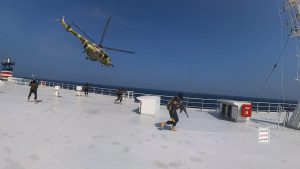A strip of operations extending from Lebanon to Syria and Iraq to Yemen.
This article was published first by Al-Akhbar
The ongoing international effort to cover Israel’s crimes in the Gaza Strip does not appear to be sufficient to ensure the success of any ground campaign in the sector. Meanwhile, the heinous crimes against civilians do not help Israel in achieving high political ceilings, shifting the debate to a new level related to readiness for a ground operation.
Apart from the practical support provided by the West, led by the United States, the leadership of the occupying army is still grappling with the mechanism of launching the ground operation and its timing, especially as the search for answers about the expected cost remains within the timeframe required for the attack, amid fears of reactions exceeding what the resistance in the sector can offer, to what the forces of the Axis of Resistance can do from outside Palestine.
Axis Coordination
In this context, it has been learned that all the forces of the Axis of Resistance across the Arab and Islamic countries have solidified the mechanisms related to providing the highest level of “effective support” for the resistance in Palestine in recent days. A group of joint operations rooms has been formed to monitor the field conditions on the side of daily and strategic activities in addition to political activity. A large number of plans have also been crystallized, creating a positive atmosphere reflected in the performance of various factions of the axis in multiple areas.
During the past 36 hours, the forces of the axis translated this into practical steps. In addition to the political positions rejecting Western requests to stop supporting Gaza, a series of coordinated military operations were carried out in multiple areas. Palestinian resistance factions continued to launch rockets into the heart of the entity, specifically Tel Aviv, and a resistance group fired a “Cornet” missile at an Israeli armored vehicle east of Khan Yunis. At the same time, the “Al-Qassam Brigades” launched a missile strike from Lebanon toward Israeli settlements in the north, while the “Saraya al-Quds” detonated explosive devices in Tulkarem, resulting in casualties among Israel’s infiltrators. Meanwhile, Hezbollah continued its operations aimed at “obscuring the occupying army” along the border with Lebanon.
According to information from “Al-Akhbar,” the resistance strikes on the front-line sites have so far resulted in the destruction of a large technical system, including advanced surveillance cameras that cover wide areas, some of which reach a range of 20 km. Special radars for individuals and vehicles erected on towers at the sites were also destroyed, in addition to a system for eavesdropping on communications and jamming and remote sensing techniques that thermally target any moving body in more than one area. According to sources, Israel is trying to compensate for these losses by deploying more drones at high and medium altitudes to cover the border front.
The resistance has been targeting and destroying a considerable number of Merkava tanks, including the “Queen” tank, which has special armor and jamming devices to disrupt “Cornet” missiles. It was noteworthy in recent days that the resistance has been using “Cornet” missiles extensively, turning them into a “personal weapon,” reflecting the presence of a huge stockpile of these missiles in its possession, in addition to the fact that not all types of these missiles have been used yet.
Activation of the Field Units
Simultaneously, the joint operations room of the forces of resistance has activated operations in other areas. A group of Iraqi resistance factions initiated consecutive drone strikes against U.S. bases in Iraq and Syria, causing direct casualties before the United States announced that its naval units intercepted missiles launched by Ansar Allah (Houthi) without specifying the precise target of these missiles, whether they were targeting American warships or military positions within occupied Palestine. Meanwhile, the Israeli army radio reported that “Israeli officials confirm to us that a number of rockets were launched from Yemen and targeted Israel, between two and five.”
The “Islamic Resistance in Iraq” also targeted the Al-Tanf base on the border triangle between Syria, Iraq, and Jordan with shells and drones. The resistance itself announced launching a drone attack on the “Ain al-Assad” base west of Baghdad, two days after the same base was subjected to a similar drone attack, coinciding with another attack on the “Harir” base in northern Iraq. Explosions were heard last night in Dhiban, Al-Hawayej, and the Al-Omar oil field, with intensive drone flights over the region. At the same time, the gas pipeline leading to the “Koniko” natural gas plant, controlled by the U.S. occupation army as its base in the northern countryside of Deir ez-Zor, eastern Syria, was blown up.
Meanwhile, massive groups of Iraqi fighters have started heading towards the Iraqi-Jordanian border. According to sources, this step comes as part of an “organized” effort, and the number of these fighters may reach tens of thousands in the coming days, prompting unprecedented Israeli military movements on the Jordanian-Palestinian border.
Israel decided on a ground operation under American ceilings, and the resistance awaits him both underground and above.
It has been learned that practical coordination among the forces of resistance aims to determine the necessary steps to drain Israel on multiple fronts and to make it clear to the Americans that its threats against the forces and countries of the resistance will be met with direct action, not just words.
It has been learned that practical coordination among the forces of resistance aims to determine the necessary steps to drain Israel on multiple fronts and to make it clear to the Americans that its threats against the forces and countries of the resistance will be met with direct action, not just words. This will be accompanied by unprecedented American and Israeli security measures, with several diplomatic missions closing in multiple countries in the region. The U.S. State Department has urged its citizens worldwide to be cautious due to the risk of retaliatory strikes against its interests stemming from its support for Israel in Palestine. Israel itself has asked its citizens to return directly to Tel Aviv and has requested various Arab and regional governments to take measures to protect their missions and citizens in light of the large-scale mobilization in the Arab and Islamic streets.
It is understood that the coordination among the forces of the Axis of Resistance will translate into significant political and popular steps against the aggression and against the American presence in the region. The countries of the axis will witness an expansion in popular support activities for the resistance in Palestine, and this will be part of an escalating course that coincides with an increase in field support for the resistance in Palestine from both inside and outside the region. Especially since Israel has intensified its security and military activities in the West Bank and has asked Jordan to make “maximum efforts” to prevent any activity through its territories.
Meanwhile, Israel was abuzz with news yesterday that a decision had been made to launch a ground operation and that the military had been tasked with providing detailed plans for approval by the political leadership. It is clear from the data, positions, and actions that the American stance is now governing Israeli decisions, especially since leaks from the meetings between U.S. President Joe Biden and Israeli officials two days ago revealed that Washington “provides significant political and military support to Israel and will prevent any decision from any international institution calling for a ceasefire or restraint.” However, in return, the Americans asked the Israeli leaders to ensure that the objectives of any ground war are realistic and achievable. In response, Israeli media quoted one of the Israeli ministers as saying in response to the U.S. president: “There is no way out of a ground operation,” and called for clarifying the goals of such an operation. Biden also publicly stated that he had never told Israeli leaders that the U.S. military would join the fight against Hezbollah if the latter initiated a preemptive war against Israel.
In this context, it has been learned that the leadership of the Al-Qassam Brigades and the Saraya al-Quds informed the joint operations room with the Axis of Resistance that they are in a high state of readiness and that the Israeli aggression has not hindered their capabilities in all domains. They emphasized that what is planned to confront any ground attack will allow for very severe strikes against the occupying forces. The sources also stated that Palestinian resistance factions have affirmed that Israel has not succeeded in hitting any tunnels in the sector and that the mobilization of thousands of fighters continues without interruption, and they possess a new type of weapons for ground confrontations.






